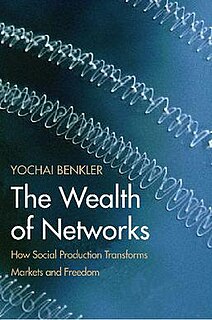Technological convergence is a tendency for technologies that were originally quite unrelated to become more closely integrated and even unified as they develop and advance. The concept is roughly analogous to convergent evolution in biological systems, such that the ancestors of whales became progressively more like fish in outward form and function, despite not being fish and not coming from a fish lineage. In technological convergence, a cardinal example to convey the concept is that telephones, television, and computers began as separate and mostly unrelated technologies but have converged in many ways into interrelated parts of a telecommunication and media industry underpinned by common elements of digital electronics and software.
Radical transparency is a phrase used across fields of governance, politics, software design and business to describe actions and approaches that radically increase the openness of organizational process and data. Its usage was originally understood as an approach or act that uses abundant networked information to access previously confidential organizational process or outcome data.
Media ecology theory is the study of media, technology, and communication and how they affect human environments. The theoretical concepts were proposed by Marshall McLuhan in 1964, while the term media ecology was first formally introduced by Marshall McLuhan in 1962.
New media are forms of media that are native to computers, computational and rely on computers for redistribution. Some examples of new media are telephones, computers, virtual worlds, single media, website games, human-computer interface, computer animation and interactive computer installations.
Ethics in technology is a sub-field of ethics addressing the ethical questions specific to the Technology Age. Some prominent works of philosopher Hans Jonas are devoted to ethics of technology. The subject has also been explored, following the work of Mario Bunge, under the term technoethics.
Denis McQuail was a British communication theorist, Emeritus Professor at the University of Amsterdam, considered one of the most influential scholars in the field of mass communication studies.
Technological change (TC) or technological development, is the overall process of invention, innovation and diffusion of technology or processes. In essence, technological change covers the invention of technologies and their commercialization or release as open source via research and development, the continual improvement of technologies, and the diffusion of technologies throughout industry or society. In short, technological change is based on both better and more technology.
In futures studies and the history of technology, accelerating change is a perceived increase in the rate of technological change throughout history, which may suggest faster and more profound change in the future and may or may not be accompanied by equally profound social and cultural change.
Theories of technology attempt to explain the factors that shape technological innovation as well as the impact of technology on society and culture. Most contemporary theories of technology reject two previous views: the linear model of technological innovation and technological determinism. To challenge the linear model, today's theories of technology point to the historical evidence that technological innovation often gives rise to new scientific fields, and emphasizes the important role that social networks and cultural values play in shaping technological artifacts. To challenge technological determinism, today's theories of technology emphasize the scope of technical choice, which is greater than most laypeople realize; as science and technology scholars like to say, "It could have been different." For this reason, theorists who take these positions typically argue for greater public involvement in technological decision-making.

According to Robin A. Williams and David Edge (1996), "Central to social shaping of technology (SST) is the concept that there are choices inherent in both the design of individual artifacts and systems, and in the direction or trajectory of innovation programs."
Emerging technologies are technologies whose development, practical applications, or both are still largely unrealized, such that they are figuratively emerging into prominence from a background of nonexistence or obscurity. These technologies are new, such as various applications of biotechnology including gene therapy. Emerging technologies are often perceived as capable of changing the status quo.

The Wealth of Networks: How Social Production Transforms Markets and Freedom is a book by Harvard Law School professor Yochai Benkler published by Yale University Press on April 3, 2006.
Media are the communication outlets or tools used to store and deliver information or data. The term refers to components of the mass media communications industry, such as print media, publishing, the news media, photography, cinema, broadcasting, and advertising.
The Toronto School is a school of thought in communication theory and literary criticism, the principles of which were developed chiefly by scholars at the University of Toronto. It is characterized by exploration of Ancient Greek literature and the theoretical view that communication systems create psychological and social states. The school originated from the works of Eric A. Havelock and Harold Innis in the 1930s, and grew to prominence with the contributions of Edmund Snow Carpenter, Northrop Frye and Marshall McLuhan.
A reverse salient refers to a component of a technological system that, due to its insufficient development, prevents the system in its entirety from achieving its development goals. The term was coined by Thomas P. Hughes, in his work Networks of power: Electrification in western society, 1880-1930.
Technology society and life or technology and culture refers to dependency co-dependence, co-influence, and co-production of technology and society upon the other. This synergistic relationship occurred from the dawn of humankind, with the invention of simple tools and continues into modern technologies such as the printing press and computers. The academic discipline studying the impacts of science, technology, and society, and vice versa is called science and technology studies.
Mediated cross-border communication is a scholarly field in communication studies and refers to any mediated form of communication in the course of which nation state or cultural borders are crossed or even get transgressed and undermined.
Lasswell's model of communication describes an act of communication by defining who said it, what was said, in what channel it was said, to whom it was said, and with what effect it was said. It is regarded by many communication and public relations scholars as "one of the earliest and most influential communication models." The model was developed by American political scientist and communication theorist Harold Lasswell in 1948 while he was a professor at Yale Law School. In his 1948 article "The Structure and Function of Communication in Society", Lasswell wrote:
[A] convenient way to describe an act of communication is to answer the following questions:
The political economy of communications, news, or media, is a particular branch in Communication studies or media studies which studies the power relations that constitute the communication of information from the mass media to its publics. The concept has been developed by media and political economy scholars, such as Dallas Walker Smythe, Herbert Schiller, Graham Murdock, Peter Golding, Vincent Mosco, Dan Schiller, and Robert W. McChesney. More specifically, PEC analyzes the social relations between the mass media system, the communication technology, and the wider social/economic structure in which it operates, with a focus on understanding both the historical emergence and current state of technological developments.


